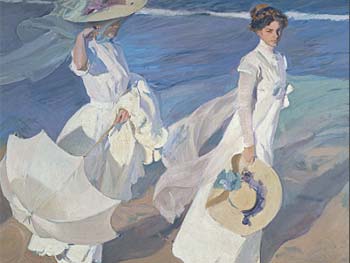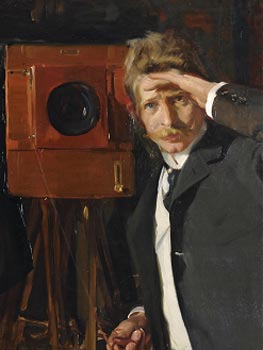The Museo del Prado unveils the first sweeping anthological show devoted to this master painter from Valencia

Joaquín Sorolla
Paseo a la orilla del mar, 1909
Madrid, Fundación Museo Sorolla
From 26th of May to 13th of September 2009, at the Museo Nacional del Prado.
MUSEO NACIONAL DEL PRADO
Pº del Prado, s/n
Madrid (España)
Edificio Jerónimos
Curator: José Luis Díez, Head of 19th Painting Department and Javier Barón, 19th Painting Department
The most important Joaquín Sorolla retrospective to date will open on the 26th of May at the Museo Nacional del Prado. Sorolla is one of the most world-famous Spanish artists, yet one whose oeuvre has almost always been shown partially. The exhibition will be comprised of over 100 pieces, including all his masterpieces along with the 14 panels that Sorolla painted on a commission from the Hispanic Society, which have been in a display that has been traveling around cities in Spain since 2007. Another fourteen of the paintings included in this show at the Prado come from Madrids Sorolla Museum.
Trained at the Real Academia de Bellas Artes de San Fernando, Sorolla learned about the output of the great Italian painters in Rome and Assisi, while in Paris he was exposed to the realistic painting that proved so decisive in the gestation of his works with a greater social consciousness, including the breathtaking ¡Aún dicen que el pescado es caro! (They Still Say that Fish is Expensive!), with its truthful rendering and painstaking attention to lighting. At the 1895 Paris Salon, the artist showed his successful Vuelta de la pesca (Bringing in the Catch), a work that would bring him fame in Europe and mark the start of his consolidation in Spain, which would gain further ground with Cosiendo la vela (Sewing the Sail). That was when he embarked on his studies into the effects of sunlight and wind on the sails of boats and on the delimitation of space in his paintings. In around 1895, Sorollas works began to be increasingly sought by a bourgeoisie that tended to commission him to paint portraits and traditional scenes.
Sorolla won the Grand Prix at the 1900 Universal Exposition with Triste herencia (Sad Inheritance), a work that belongs to the Bancaja collection in which he explores the possibilities of the seashore as the backdrop of his paintings. This milestone turned him into the most successful Spanish artist at the turn of the century. His works from this period drew not just from Italian and French sources nor merely from the constant inspiration he got from the beaches and people of Valencia. Rather the influence of Velázquez, whose oeuvre Sorolla had become familiar with through trips to the Prado and whose many portraiture models he had internalized, was crucial in works like his little-known Desnudo de mujer (Female Nude, 1902).

Reflejos de una fuente, 1908
Madrid, Fundación Museo Sorolla
Sol de la tarde (Afternoon Sun) is another of the key paintings in the show because of the sweeping freedom with which Sorolla confronted the canvas, the monumentality of its figures and the realism with which he captures the choppiness of the sea. His success in both Spain and abroad enabled him to adopt original prototypes around which he developed his art, especially the portraits of his family and the sensual, iconic images of the beach. They stand out for their overwhelming luminosity, the matter employed, the exuberant Mediterranean classicism of the figures that appear in them and the appealing reality that they portray. In this they starkly contrasted with the works from the same period by artists linked to the Generation of 98, who rendered a darker and more pessimistic tone. Sorolla painted his last works, landscapes captured from unusual vantage points using a fresh, direct technique, in the garden of his home in Madrid, the current location of the museum devoted to this painter.

Joaquín Sorolla
El fotógrafo Christian Franzen, 1903
Colección particular




